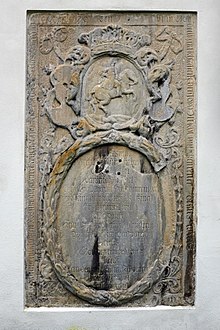Christoph Michael Hutschenreuther
Christoph Michael Hutschenreuther also Hutschenreiter (* around 1628; † February 28, 1707 in Heinrichsgrün ), was a Bohemian hammer master, landowner and entrepreneur who was raised to the nobility.
Life
Christoph Michael Hutschenreuther, member of an old hammer family, was possibly a close relative of the hammer Hans Hutschenreuther . The family later became known primarily through their porcelain manufacture . Hutschenreuther acquired Gut Winklau, a former Meierhof, from which the town of Ober-Rothau later developed. Before him, the estate belonged to Hans von Winklau, court master of Count Schlick . According to the church chronicle of Heinrichsgrün, Hutschenreuther was also the owner of an important property in Unter-Rothau. His place of residence in Heinrichsgrün with its own office is said to have been next to the town hall and town hall. The corner house on the street that leads to the castle is considered the oldest of Heinrichsgrün. Hutschenreuther was raised to the nobility due to his "self-sacrificing work" and carried a crowned coat of arms with a rider. As early as 1696 he sold his estate to the Counts of Nostitz , who shared the property and leased it to subjects. He was born with Rosina Pöschl married, who died on April 20, 1705 at the age of 72 and was buried in the church of Heinrichsgrün under the altar by the pulpit. The marriage remained childless. Hutschenreuther himself died on February 28, 1707 at the age of 79 and was buried in a crypt next to the old church in Heinrichsgrün.
Tomb
The tombstone made of white silica sandstone, which was commissioned by Christoph Michael Hutschenreuther after the death of his wife in 1705 and which should also apply to himself, was originally located on the churchyard wall and was placed in the church below the pulpit in 1800. It was not removed from there until 1845 and the confessional was replaced. Since then, the grave slab has been attached to the outside wall of the church below the church tower.
Individual evidence
- ^ Johann Gottfried Johann Gottfried Sommer : The Kingdom of Bohemia. Volume 15: Elbogner Kreis. Calve, Prague 1847, pp. 72-74 .
- ↑ Kronika fary | Porta fontium. Retrieved May 2, 2018 .
- ↑ Jaroslaus Schaller : Topography of the Kingdom of Bohemia, in which all cities, towns, lordships, manors, castles, estates, noble estates, monasteries, villages, as well as dilapidated castles and cities under the former and current names including their peculiarities are described. Part 2: Ellbogner Kreis. Piskaczek, Prague 1785, p. 58 .
- ↑ Jaroslaus Schaller: Topography of the Kingdom of Bohemia, in which all cities, towns, lordships, manors, castles, estates, noble estates, monasteries, villages, as well as dilapidated castles and cities under the former and current names including their peculiarities are described. Part 2: Ellbogner Kreis. Piskaczek, Prague 1785, p. 53 .
| personal data | |
|---|---|
| SURNAME | Hutschenreuther, Christoph Michael |
| ALTERNATIVE NAMES | Hutschenreiter, Christoph Michael |
| BRIEF DESCRIPTION | Bohemian landowner, entrepreneur and chancellery who was raised to the nobility |
| DATE OF BIRTH | around 1628 |
| DATE OF DEATH | February 28, 1707 |
| Place of death | Heinrichsgrün |
